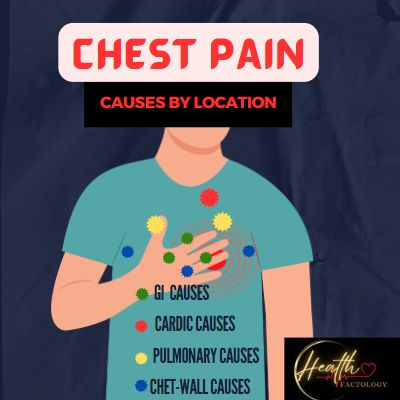Experiencing chest pain can be a frightening and unsettling experience. It’s important to understand that chest pain can manifest on the left side, the right side, or even in the middle, depending on the structures involved. In this comprehensive blog post, we will unravel the mysteries of chest pain, exploring its various causes and associated locations. By shedding light on the factors that contribute to this discomfort, including the heart, lungs, ribs, muscles, and other anatomical structures, we aim to provide you with a clear understanding of this symptom.
What can cause Left Side Chest Pain:
Left-sided chest pain can stem from several underlying causes, primarily involving the heart and its related structures. The causes may include:
- Myocardial Infarction
- Angina
- Pericarditis
- Myocarditis
- Valvular diseases (Aortic stenosis and Mitral valve prolapse)
- Acute coronary syndrome
- Aortic aneurysm
- Coronary Artery Disease
- Coronary artery dissection
- Hypertrophic cardiomyopathy(HOCM)
However, it’s essential to consider other potential sources. Abdominal issues like pancreatitis and gastritis primarily cause pain in the upper tummy (involving its left part or maybe somewhat center) that can occasionally radiate to the left lower chest. Hiatal hernia, commonly associated with gastroesophageal reflux disease (GERD) and difficulty swallowing, is another possible cause.
Understanding these diverse origins of left-sided chest pain is crucial for recognizing potential health concerns and seeking appropriate medical evaluation.
Middle Chest Pain Causes:
Chest pain occurring in the middle can stem from various factors and conditions. Some common causes include:
- Causes related to Gastrointestinal tract
- Causes due to the musculoskeletal system
- Certain other nonspecific causes
Gastrointestinal causes leading to chest pain in the middle are related to the esophagus (the food pipe) as it is the only structure of the gastrointestinal tract present in the chest and the only major structure running through the middle of the chest. These esophageal causes included here are:

- GERD (Gastroesophageal reflux) (GERD), where stomach acid flows back into the esophagus and leads to a burning sensation in the middle of the chest.
- Esophagitis
- Esophageal Muscular Spasm
- Esophageal ulcer due to prolong use of NSAIDS or other medications.
Musculoskeletal Issues Causing middle chest pain are:
- Costochondritis (Tietze Syndrome) is an inflammation of the cartilage connecting the ribs to the breastbone, resulting in sharp pain in the middle of the chest.
Additionally, chest pain in the middle can be triggered by some other nonspecific conditions such as:
- panic attacks, anxiety, and stress.
- Lymph node involvement can also contribute to chest pain in the center. When lymph nodes in the chest region become enlarged or inflamed due to various factors, they can cause discomfort and pain in the middle of the chest.
Right-Sided Chest Pain:
The major Gastrointestinal issue causing right-sided chest pain is
- Gallbladder disease or stones although it is abdominal structure and pain is abdominal but can be felt In the lower part of the chest to the right side.
- Lung causes and chest wall causes are similar to that mentioned in left-sided causes
What Causes Left or Right-Sided Pain in the Chest:
Lung issues can lead to either left-sided or right-sided chest pain depending upon which side of the lung and related vessels are involved. It can be bilateral if both sides are involved. The major causes include:
- Pulmonary Hypertension
- Pulmonary embolism
- Asthma is associated with wheezing and chest tightness.
- COPD (Chronic obstructive pulmonary disease) is usually expressed by a patient as chest tightness.
- Pneumonia typically causes chest pain when you breathe or cough.
- Pleurisy, and pleuritis
- Pneumothorax and Haemothorax cause lung collapse and can cause chest pain of sudden onset along with shortness of breath.
- Lung Cancer
Some Chest wall conditions can lead to pain on the right or left side of the chest depending o the side involved including:
- Broken ribs
- Muscular spasm
- Shingles
Conclusion:
In conclusion, being aware of the various causes of chest pain empowers us to prioritize our health with confidence. While GERD is a frequent cause, it is essential to approach chest pain seriously, considering other factors such as cardiac, musculoskeletal, and lymph node involvement. By recognizing the complexities involved and seeking timely medical attention, we assert our commitment to overall well-being and ensure appropriate interventions when necessary. Remember, your health matters, and by taking proactive steps to address chest pain, including cardiac evaluation, you assert control over your well-being and pave the way for a healthier and more vibrant life.


